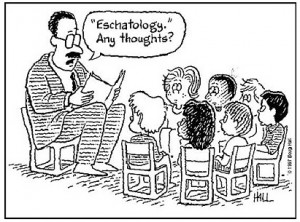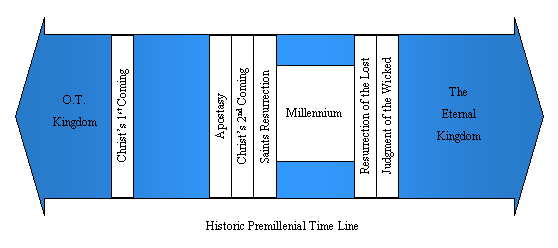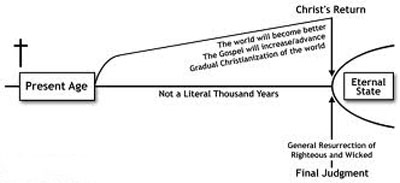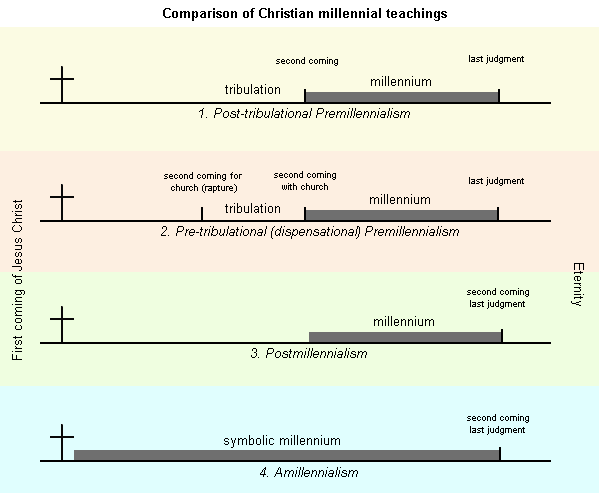By Cris D. Putnam
 I just listened to a “back and forth” on Issues Etc. a Lutheran radio show that I generally like for its discussion of apologetics and theology. They had Dr. Thomas Ice on talking about “Rapture Theology” and then a follow up response by Dr Kim Riddlebarger Responding to Dr Thomas Ice’s Rapture Theology. While I identify as a progressive dispensationalist, I do not really want to debate the timing of the rapture rather the strawman representation of premillennialism and complete white washing of classic Lutheran eschatology displayed by the host of Issues Etc. and Riddlebarger. One of the major objections to dispensationalism was that it was relatively new development of the nineteenth century whereas the Amillennial view was the classic protestant view. This is a drastic oversimplification of the Lutheran and Reformed positions.
I just listened to a “back and forth” on Issues Etc. a Lutheran radio show that I generally like for its discussion of apologetics and theology. They had Dr. Thomas Ice on talking about “Rapture Theology” and then a follow up response by Dr Kim Riddlebarger Responding to Dr Thomas Ice’s Rapture Theology. While I identify as a progressive dispensationalist, I do not really want to debate the timing of the rapture rather the strawman representation of premillennialism and complete white washing of classic Lutheran eschatology displayed by the host of Issues Etc. and Riddlebarger. One of the major objections to dispensationalism was that it was relatively new development of the nineteenth century whereas the Amillennial view was the classic protestant view. This is a drastic oversimplification of the Lutheran and Reformed positions.
In truth, Historicism was a foundational interpretation of Protestantism and it is perplexing that it is so flippantly forgotten. They completely ignore the subversion of Biblical doctrine by the Roman Catholic Church and the fact that many early Fathers were Premillennial. Even worse, the host and Riddlebarger made sport of premillennialists for speculating on current events in Israel as prophetically significant while ignoring the Historicist view (see p1 p2 p3 ) of the reformed tradition’s tendency to do the same. In fact, far from demuring to speak to current events, classic Protestantism has affirmed that the Great Tribulation as an ongoing reality along with the judgements of the book of Revelation. In the recent past Protestants did not speculate about the identity of Antichrist, they claimed sure knowledge. It is in all of the creeds!
Despite political correctness and its nearly forgotten status in modern evangelicalism, almost all of the original protestant confessions affirm that the papacy is antichrist. For example, The Second Scotch Confession of AD 1580 states:
And theirfoir we abhorre and detest all contrare Religion and Doctrine; but chiefly all kynde of Papistrie in generall and particular headis, even as they ar now damned and confuted by the word of God and kirk of Scotland. But in special, we detest and refuse the usurped authoritie of that Romane Antichrist upon the scriptures of God, upon the Kirk, the civill Magistrate, and consciences of men.[1]
Similarly, The Westminster Confession of Faith does not mince words concerning the papacy:
There is no other head of the Church but the Lord Jesus Christ.Nor can the Pope of Rome, in any sense, be head thereof: but is that Antichrist, that man of sin, and son of perdition, that exalteth himself, in the Church, against Christ and all that is called God.[2]
This statement was repeated virtually verbatim in the Baptist Confession of 1688, otherwise known as the Philadelphia Confession. It was the most generally accepted confession of the Regular or Calvinistic Baptists in England and in the American south. The Westminster confession is still widely used today.
While many modern Lutherans seek to distance themselves from it, The Book of Concord still contains the Smalcald Articles and the Treatise on the Primacy of the Pope. Accordingly, many orthodox Lutherans still affirm the veracity of those documents. However, in the 1860s the Iowa Synod refused to grant doctrinal status to the teaching that the Papacy is the Antichrist. They listed this teaching under the category of “open questions.” The Iowa Synod later became part of the American Lutheran Church, and its teaching on the Antichrist persisted in the new union. Since 1930, the ALC taught that it is only a “historical judgment” that the Papacy is the Antichrist. In 1938, this view was officially sanctioned in the ALC “Sandusky Declaration.” It stated:
We accept the historical judgment of Luther in the Smalcald Articles…that the Pope is the Antichrist…because among all the antichristian manifestations in the history of the world and the Church that lie behind us in the past there is none that fits the description given in 2 Thess. 2 better than the Papacy…
The answer to the question whether in the future that is still before us, prior to the return of Christ, a special unfolding and a personal concentration of the antichristian power already present now, and thus a still more comprehensive fulfillment of 2 Thess. 2 may occur, we leave to the Lord and Ruler of Church and world history.[3]
In a sharp rebuttal, the Missouri Synod’s “Brief Statement” of 1932 renounced the teaching that the identification of the papacy as the Antichrist is only a historical judgment. It professed, “The prophecies of the Holy Scriptures concerning the Antichrist…have been fulfilled in the Pope of Rome and his dominion.” It subscribed, “to the statement of our Confessions that the Pope is ‘the very Antichrist.’” It argued that the doctrine of Antichrist is “not to be included in the number of open questions.”[4] However, their position has softened since.
In 1951, the Report of the Advisory Committee on Doctrine and Practice of the Lutheran Church—Missouri Synod stated:
Scripture does not teach that the Pope is the Antichrist. It teaches that there will be an Antichrist (prophecy). We identify the Antichrist as the Papacy. This is an historical judgment based on Scripture. The early Christians could not have identified the Antichrist as we do. If there were a clearly expressed teaching of Scripture, they must have been able to do so. Therefore the quotation from Lehre und Wehre [in 1904 by Dr. Stoeckhardt which identifies the Papacy as Antichrist] goes too far.[5]
This view was endorsed at the Missouri Synod Convention in Houston in 1953. Even so, many still struggle with their traditions. A Lutheran scholar, Charles Arand, wrote an article to help contemporary Lutheran’s deal with the cognitive dissonance they feel when they want to applaud the pope’s position against abortion and other moral issues. While he never denies the classic Lutheran position, he claims, “The identification of the papacy as the Antichrist in the Confessions takes place in an apocalyptic climate in which the Reformers also considered other candidates for the title of Antichrist, the most prominent of which were the Turks (Ap XV, 18).”[6] The text he refers to is this one: “For the kingdom of the Antichrist is a new kind of worship of God, devised by human authority in opposition to Christ, just as the kingdom of Mohammed has religious rites and works, through which it seeks to be justified before God.”[7]
Indeed, one could infer a Muslim antichrist from this one statement. But, in truth, his use of this reference is obfuscation because the very next sentences in Apology of the Augsburg Confession XV, 18 say:
It does not hold that people are freely justified by faith on account of Christ. So also the papacy will be a part of the kingdom of the Antichrist if it defends human rites as justifying. For they deprive Christ of his honor when they teach that we are not freely justified on account of Christ through faith but through such rites, and especially when they teach that such rites are not only useful for justification but even necessary.[8]
This issue of elevating their rites above the salvific power of the Gospel has never been recanted by the Church of Rome. He goes on to argue that as part of the “already but not yet” paradigm, the papacy was a manifestation of Antichrist during the time of the reformation but not necessarily the ultimate one. Nevertheless, this confession clearly says they will be a part of Antichrist’s kingdom. He maintains to be dogmatic that the papacy is the only antichrist precludes awareness and vigilance toward new manifestations, yet to relativize the confessions as only historical is equally an error.[9] So contrary to views expressed on the recent Issues Etc, dispensationlism did not amend their anemic modernized view rather hard-line Historicism.
It is a demonstrable historical fact that every notable protestant theologian of the 16 -19th century, regardless of denomination, believed and taught that the papacy was antichrist.
For a cogent Defense of premillennialism I recommend John MacArthur’s series here.
[1] The Second Scotch Confession in Philip Schaff, The Creeds of Christendom, Volume III (Joseph Kreifels), 349.
[2] Morton H. Smith, Westminster Confession of Faith (Greenville SC: Greenville Presbyterian Theological Seminary Press, 1996), 2.
[3] “Statement on the Antichrist,” Wisconsin Evangelical Lutheran Synod, last accessed January 18, 2011, http://www.wels.net/about-wels/doctrinal-statements/antichrist?page=0,1.
[4] Ibid.
[5]Ibid.
[6] Charles P. Arand, “Antichrist: The Lutheran Confessions on the Papacy,” Concordia Journal (October 2003), 402.
[7] Philip Melanchthon, Apology of the Augsburg Confession XV,18 in Robert Kolb, Timothy J. Wengert and Charles P. Arand, The Book of Concord : The Confessions of the Evangelical Lutheran Church (Minneapolis: Fortress Press, 2000), 225.
[8] Ibid.
[9] Charles P. Arand “Antichrist: The Lutheran Confessions on the Papacy,” 403.






